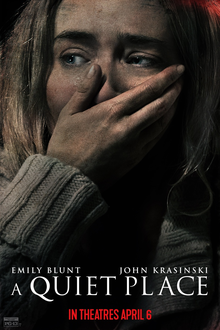“A Quiet Place” has captivated audiences worldwide with its unique premise and terrifying suspense. The film’s success lies not only in its chilling story but also in its commitment to accessibility. By incorporating integrated sign language subtitles, “A Quiet Place” ensures that viewers who are deaf or hard of hearing can fully engage with the narrative, creating a truly inclusive cinematic experience. This article delves into the innovative approach taken by the filmmakers and explores the impact of these subtitles on both the film’s storytelling and its audience reception.
This article will examine how “A Quiet Place” utilizes integrated sign language subtitles to enhance accessibility for deaf and hard-of-hearing viewers. We’ll explore the specific techniques employed, analyze their effectiveness in conveying the story, and discuss the broader implications of this approach for inclusive filmmaking.
Accessible Horror
Horror films often rely heavily on sound design to create suspense and fear. The absence of dialogue in “A Quiet Place” amplifies this reliance, making it a unique challenge for deaf and hard-of-hearing viewers. However, by integrating sign language subtitles, the filmmakers have successfully bridged this gap, allowing all audiences to experience the full impact of the film’s terrifying atmosphere.
The use of sign language in “A Quiet Place” is not simply a matter of translation; it becomes an integral part of the storytelling itself. Characters communicate through sign language both within the narrative and with the audience, creating a sense of immediacy and connection that transcends spoken dialogue. This approach elevates the film beyond a mere adaptation for accessibility; it transforms the horror experience into something truly unique and engaging for all viewers.
The integration of sign language also adds a layer of depth to the characters’ emotions and relationships. Facial expressions and body language, which are crucial elements of sign language, convey subtle nuances that might be missed through spoken dialogue alone. This allows deaf and hard-of-hearing viewers to fully understand the characters’ motivations, fears, and hopes, enriching their overall understanding of the story.
Integrated Sign Language Subtitles
The subtitles in “A Quiet Place” are not simply a transcription of the spoken dialogue; they are carefully crafted to reflect the nuances of sign language. The filmmakers worked closely with deaf consultants to ensure that the subtitles were both accurate and natural-sounding, seamlessly integrating them into the visual landscape of the film.
Subtitles as Part of the Narrative
The use of integrated sign language subtitles in “A Quiet Place” goes beyond mere accessibility; it becomes a storytelling tool in its own right. The subtitles are not simply a translation of the spoken dialogue but rather an integral part of the narrative, enriching the viewer’s understanding of the characters and their relationships.
Visual Storytelling
The integration of sign language subtitles also enhances the film’s visual storytelling. By incorporating hand gestures and facial expressions into the subtitles, the filmmakers create a more immersive and engaging experience for viewers. This approach allows deaf and hard-of-hearing viewers to fully participate in the film’s visual narrative, experiencing the story through both sight and movement.
A Quiet Place Film
“A Quiet Place” is not just a horror film; it’s a testament to the power of inclusive storytelling. By incorporating integrated sign language subtitles, the filmmakers have created a cinematic experience that is accessible and engaging for all audiences. The film’s success demonstrates that accessibility can be both commercially viable and artistically rewarding.
Critical Acclaim
“A Quiet Place” has received widespread critical acclaim for its innovative approach to storytelling and its commitment to accessibility. Critics have praised the film’s suspenseful plot, strong performances, and groundbreaking use of sign language subtitles. The film’s success at the box office further demonstrates the growing demand for inclusive content that caters to a diverse audience.
Immersive Cinematic Experience
The integrated sign language subtitles in “A Quiet Place” create an immersive cinematic experience unlike any other. Viewers are drawn into the world of the film through both visual and auditory cues, experiencing the story on a deeper level than traditional horror films allow. This approach transcends language barriers, creating a shared experience that unites audiences regardless of their hearing abilities.
Breaking Down Barriers
The use of integrated sign language subtitles in “A Quiet Place” breaks down barriers between deaf and hearing viewers, fostering a sense of inclusion and understanding. By presenting the story through both spoken dialogue and sign language, the film acknowledges the diverse needs of its audience and creates a more equitable cinematic experience for all.
Inclusive Storytelling
“A Quiet Place” serves as a powerful example of inclusive storytelling. The filmmakers’ decision to integrate sign language subtitles demonstrates their commitment to representing deaf and hard-of-hearing individuals in a meaningful and authentic way. This approach not only enhances the film’s accessibility but also challenges societal norms and promotes greater understanding between different communities.
Representation Matters
The inclusion of sign language in “A Quiet Place” is more than just a technical detail; it represents a significant step towards greater representation of deaf and hard-of-hearing individuals in mainstream media. By showcasing the beauty and complexity of sign language, the film challenges stereotypes and promotes a more inclusive understanding of disability.
Conclusion
“A Quiet Place” stands as a landmark achievement in accessible filmmaking. Through its innovative use of integrated sign language subtitles, the film has created an immersive and inclusive cinematic experience for all audiences. The success of “A Quiet Place” demonstrates that accessibility is not only a moral imperative but also a powerful storytelling tool that can enrich the viewing experience for everyone. By embracing inclusivity, filmmakers can create truly groundbreaking works of art that resonate with diverse audiences and challenge societal norms.



